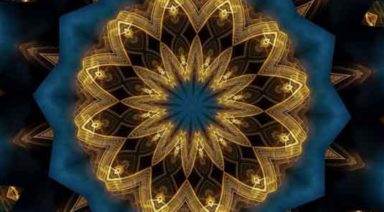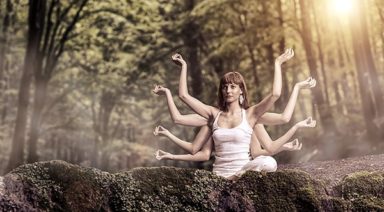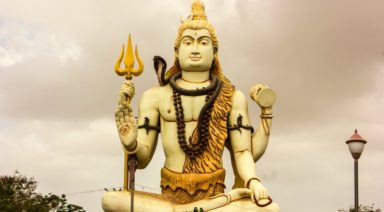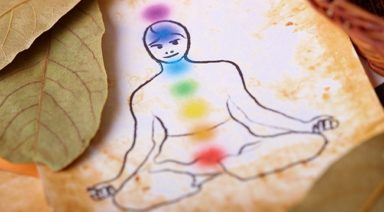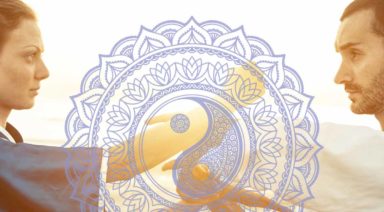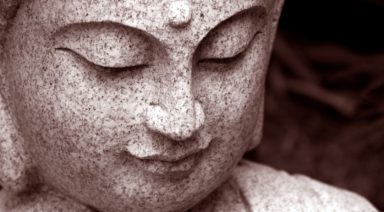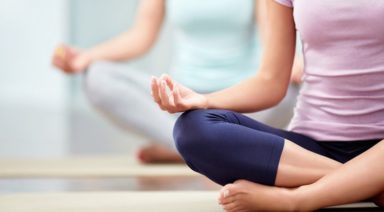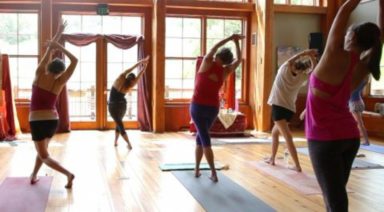Naljor: A Buddhist Approach to Yoga

The current popularity of yoga stands at all time high in the 5,000 years of its existence. Numerous celebrity endorsements, features in mainstream media, and the proliferation of online resources have introduced millions of people to the potential benefits of a regular practice. As a consequence, people around the world are picking up yoga mats and heading down to their local studios for weekly rounds of sun-salutations and warrior’s poses in the hopes of achieving stress relief, balance and improvements in overall health and well being.
Of course, anyone who spends time on the mat realizes that yoga is about much more than just the poses. Patanjali’s Yoga Sutras define yoga as a “cessation of vacillation of thought”. Other translations include “yoking” or “union”. That which must be yoked or harnessed, according to the late yoga scholar Georg Feuerstein “is attention, which ordinarily flits from object to object”. The ability to concentrate attention is what allows the yogi to work directly with the mind and ultimately to unify the lower self with the higher self.
The Golden Statue Wrapped in Rags
Tibetan Buddhist practitioners define yoga slightly differently than their Hindu counterparts. The word yoga, according to the Tibetan Buddhist Master Namkhai Norbu is rendered “naljor” in Tibetan. According to Norbu, “nal literally means original or authentic and jor means to discover or possess this condition. Accordingly, the meaning of naljor is to discover our real condition.”
The story of the “Golden Statue Wrapped in Rags”, which can be found in Arya Maitreya’s “Uttara Tantra”, illustrates this process of inner discovery through metaphor:
A god, having discovered by the road a precious [statue] of a Tathagata [Buddha] all wrapped in smelly tattered rags, would tell someone the fact of it lying there at the roadside, so that it might be recovered. Similarly, when the Buddhas, of unhindered vision, see the very substance of the Tathagatas [Buddhas] even in animals present but wrapped within the envelope of defilement, they also show the means by which it may be set free.
Encountering The Buddha Within
In Buddhist practice, there are many Buddhas, some male and some female. However, these Buddhas are not representative of an external God or object of worship – rather, they serve as a symbolic representation of our own inner potentialities for limitless wisdom, love and compassion. Collectively these qualities are known as our Buddha nature.
Our Buddha nature is pure and beautiful – much like a golden statue. When our mind is untroubled, our body is relaxed, and our breath is calm and quiet, we can sometimes even catch a glimpse of the Buddha within. As we come to rest in the quiet of our inner space, we quite naturally and spontaneously find ourselves able to feel more open, loving and able to see things from a broader perspective.
Unfortunately, the converse is also true. When we’re stressed out or threatened in some way, or when we have a lot of mental chatter, we can also see that we have the potential for hatred, obsessiveness, ignorance and many other destructive emotions within us. In many ways, these destructive emotions are very similar to a set of “tattered rags” that obscure our inner potentialities.
If these destructive emotions become strong enough, they can make it difficult to make meaningful contact with our Buddha nature. In fact, if our minds are deeply obscured by destructive emotions, those emotions can even make us forget that we, or others, have a Buddha Nature at all.
The Buddha is Present in Every Living Being
According to the metaphor, a God, or a Buddha has the divine vision and wisdom necessary to see that the mind of every living life form is ultimately pure. Supported by this vision, the gods and the Buddhas are able to see beyond our obscurations in order to ascertain our true inner value.
According to Tibetan Buddhist teacher Thrangu Rinpoche, the Buddhas in particular remind us that we should “remove the tattered rags so the Buddha nature can manifest in its complete purity”.
How Do We Uncover the Golden Statue?
In order to “remove the tattered rags”, a yogi or yogini in the Tibetan Buddhist tradition practices naljor. In this context, naljor (or yoga) refers to the methods employed during the process of purification. In order to be considered authentic, these purification practices have to come from an enlightened source – namely a Buddha that originally achieved enlightenment through their practice.
Naljor: A Diverse Set of Practices
The yoga utilized in naljor practice can generally be categorized in three separate ways.
Practices for the Body
Many emotional obscurations can be linked to energetic blockages and damage to our energetic channels (nadis). When a yogi or yogini experiences ill health emotional disturbances, or difficulties in meditation, physical asanas can be used to move energy and repair damage to the energy system. In my tradition, these techniques are called “Mangalam Yantra Yoga”. Some schools also refer to these techniques as “Trul Khor” or the magical wheel.
Practices for Speech
Breath is life and the wind that gives voice to our speech. As such, purification of speech is heavily dependent on conscious breathing exercises (Vayu Yogas) and the repetition of mantra.
Practices for the Mind
In naljor practice, meditation serves as one of the primary yogas used to purify the mind. At the initial stages of practice, one uses concentration to create a calm abiding state of mind (shamatha) to develop deeper insights into the true nature of the self and external reality (vipassana). In addition, naljor practitioners also use meditation to cultivate the altruistic wish to achieve enlightenment for the sake of all sentient beings (Bodhichitta). Typically, this is done by meditating on loving kindness, compassion and giving and taking (tong len).
At the higher stages of practice, a yogi/ni learns how to meditate directly on the Buddha within by visualizing themselves as a Buddha. It is said that by practicing visualization in this way, the immense qualities of the Buddha can arise within a practitioner within one single lifetime.
Yoga All Day Every Day
Naljor practices are designed to be fully integrated into all aspects of daily life. Some are practiced during waking hours, and others, such as dream yoga are practiced during sleep. Ultimately, when these techniques are blended with daily living, naljor becomes a 24-hour per day practice that can be extended over a lifetime.
By practicing in this way, every moment becomes an opportunity for positive transformation and awakening.
Does Buddhism Belong in a Yoga Class?
These days, most people associate yoga techniques with “Hindu” yoga practices. This is partly due to the fact that many of the modern yoga teachers responsible for popularizing the practice were Hindu practitioners, such as Parahahansa Yogananda, B.K.S. Iyengar and Pattabhi Jois. As a consequence, many people have come to think of yoga as a distinctly Hindu discipline.
While it’s true that many yoga practices can be traced to Hindu origins, there are also yoga practices with Jain and Buddhist roots. According to the contemporary Buddhist Master H.H. the Sakya Trizin, yogic practices were used by practitioners from both Buddhist and Hindu religions in the fourth and fifth centuries A.D. and reached their peak in India in the 10th and 11th centuries.
Fortunately, early yogic practitioners from Hindu and Buddhist lineages were not hindered by differences in their respective traditions. In fact, H.H. the Sakya Trizin states that “they were not interested in labels, any more that a nuclear physicist cares about his nationality when he compares notes with a foreign colleague.”
Since these practitioners were primarily interested in meditative realization, they regularly interacted with one another and regularly debated on the effectiveness of their methods and techniques. In fact, one of the earliest recognized figures in Hatha Yoga, the MahaSiddha Gorakshanath, is known to have practiced both Hindu and Buddhist yogas.
Thus, the exchange of ideas between Buddhist and Hindu yoga practitioners is nothing new and has been an accepted practice for centuries. In fact, it is widely known that T. Krishnamacharya himself, the teacher of both Pattabhi Jois and B.K.S. Iyengar, traveled to Tibet in order to study yoga directly with a Tibetan Guru for over seven years in the early part of the 20th century.
Empowerment and Introduction to the Buddha Nature
Traditional naljor practices are typically done as a daily practice (sadhana). A sadhana is an incredibly powerful tool, and one of the most sophisticated methods of physical and psychological transformation ever taught. When practiced daily in its unaltered form, the potential for transformation, insight and healing that it unleashes is unparalleled.
Most sadhana practices are secret practices that are transmitted directly from a Buddhist meditation master (Vajra master) to a student in the form of a ritualized ceremony called an empowerment (abhishekha). During the empowerment, the Vajra master symbolically introduces a student to his or her Buddha nature, confers a mantra, and extends permission to undertake yoga practices associated with a particular Buddha or Buddha family.
Naljor-Inspired Yoga Practice
Traditionally, undertaking the empowerment ritual requires a formalized commitment to Buddhist practice and study, the undertaking of vows, and a commitment to serve the lineage from which the practice derives. This is not always possible for a number of reasons.
If you wish to explore a naljor practice inspired by Tibetan Buddhism, explore David’s four-video practice (coming soon).
Each video in the series begins with a simple breathing exercise to purify your speech, continues on to a set of simple physical poses designed to release physical blockages from your body and ends with a traditional meditation from the Tibetan Buddhist tradition to purify the mind.
Accessible Practices for Everyone
While the breathing exercises and physical practices contained in these videos are drawn from common, every day yoga techniques that you may be familiar with, the meditations themselves are drawn directly from Buddhist contemplations which can be found in many traditional sadhanas. Practicing these meditations requires no formal commitment, and their focus on the cultivation of very human qualities such as love and compassion makes them applicable to practitioners from all faith and backgrounds.
These profound contemplations will guide you through the process of mental purification and will connect to yourself and others in a genuine and meaningful way. Over time, these powerful practices will help you make contact with the Buddha within and will help you begin the process of uncovering the limitless love, compassion and wisdom that exists within all living beings.
May your practice bring you peace.
Yoga Mala

A mala, meaning garland in Sanskrit, evokes a circular, continuous form. In practice, a mala is the devoted offering of repeated cycles (typically in divisors of 108) of mantra Japa or yoga asana. Within a mala, there is always a sense of beginning, continuing, and completion. Both inside each individual cycle and in the practice as a whole. This three-form (trimurti) quality allows us to embody, in practice, the rhythmic cycles ever-present in the natural universe: creation (srishti), sustaining (sthiti) and destruction (samhara).
During a yoga mala, the types of offerings include mantra japa, pranam and yoga.
Offering: Mantra Japa
Chanting mantra, either internally or aloud, has a vibrational impact on the body and mind. A mantra, meaning a tool or skill of thought, imbues the practice of yoga with a primordial rhythm and when offered continuously (japa), mantras are designed to liberate consciousness.
“Mantras are the sounds that should accompany our yoga postures. Like strands of DNA, these sounds offer yoga practitioners a direct link to the source and substance of the yoga tradition. Just as you cannot truly grasp science without knowing its language—mathematics— it is impossible to touch upon the depth of yoga without knowledge of mantras.” ::Russill Paul, The Yoga of Sound
When preparing to practice mantra Japa, select a mantra that resonates with what you want to cultivate through your offering. Included below are several mantras that serve different purposes in practice. They are short, potent and readily learned through repetition. While an English mantra may be just as powerful, the Sanksrit mantras are intelligently crafted to awaken your whole being with vibration, not just the mind.
| MANTRA | MEANING | INTENTION |
|---|---|---|
| oṁ namaḥ shivāya | I bow to the inner Self who is one with the source of all creation | union |
| oṁ hrim hamsa soham svaha | I bow to the supreme light, to emerge from darkness | purification |
| oṁ maṇi padme hūṃ | May the jewel in the lotus shine forth the light and love of compassion to unite all as one. | compassion |
| oṃ guṃ gaṇapataye namaha | I bow to Ganapati the benevolent remover of obstacles. | overcoming obstacles |
| lokāh samastāh sukhino bhavantu | May all beings everywhere be happy and free. | metta, lovingkindness |
Offering: Pranam
For a gentle, yet transformative practice, you may choose to offer pranams (prostrations) in lieu of the traditional namaskaras (salutations) outlined below. The practice of prostration or kneeling is common to many spiritual traditions and the physical gesture of bowing is understood universally as conveying respect, honor, and reverence.
A pranam is the simple surrender of the whole body to the earth in a prone position.
Begin standing, then lower the hands to the ground and slowly walk them away from the feet to place the belly on the floor. Rest the forehead on the hands like a pillow and stay here for at least one cycle of breath. To complete the pranam, in your own way, press the body up off the floor and return to standing. Use the breath to initiate each movement and move slowly. With relatively uncomplicated form, a mala of pranams may be completed with the eyes closed to facilitate deeper focus and meditation.
Offering: Yoga
A yoga mala can be completed using any combination of practices that totals 108, or for a shortened practice, 27, 54, etc. My favorite way to practice a yoga mala is by completing 12 total cycles, each consisting of 7 surya namaskar A and 2 surya namaskar B, 12 x 9 = 108. Typically, postures for traditional sequences.
Modifications
In this style of yoga mala, there are potentially more than 200 forward bends and more than 150 “push-ups”; For even the most seasoned yoga practitioner, this is a lot to ask of the body. Listed below are common modifications to the traditional form to encourage a sustainable practice that leaves you feeling nourished, not depleted. You may decide to modify every round or alternate between full and modified expressions as is appropriate.
Upper Body
- Bend the elbows for any postures where the arms are extended overhead. This is a great option for anyone with shoulder sensitivity or as the arms begin to fatigue. This can also alleviate dizziness and is recommended for anyone with hypertension
- Skip the basic vinyasa (chaturanga and upward facing dog) and step straight back to downward facing dog from forward bending. Enjoy a few extra moments to catch your breath in downward dog or rest in child’s pose instead
- Substitute cobra or locust pose for upward dog. These postures extend the spine in the same way with little to no weight bearing on the hands
- Substitute forearm plank and dolphin for plank and downward dog for sensitive wrists. When taking this modification, it is recommended to transition slowly from hands to forearms with the knees lowered
- Substitute puppy pose or child’s pose for downward dog, placing less weight on the hands
Lower Body
- Bend the knees in forward bends. This is recommended for all practitioners, even those with an advanced forward bending practice who can very easily touch the ground with straight legs. A gentle bend in the knees will help recruit the larger muscles of the legs for support, especially when the body becomes fatigued, instead of defaulting to the knees and lower back. Similarly, maintain a gentle bend in the knees as you transition from forward bending to standing
- Substitute high or low lunge for warrior one. Lowering the back heel in this split-leg posture requires significant mobility in the hips and legs, enjoy these lunge modifications for several rounds in the beginning until the body is sufficiently warm or as alternatives to warrior one when the legs become tired
Transitions
- With a fluid and repetitive rhythm, it can be easy to hurry from one pose to the next. A mala can be practiced with one breath per movement, but enjoy additional breaths as needed and do not rush through the process. It is far better to complete 54 rounds safely and with self-compassion than to suffer through 108 for the sake of the numerical metric
Your Practice is Personal
The practice of a yoga mala can be deeply cleansing and invigorating, especially when completed during a seasonal shift such as a solstice or equinox. This practice is also welcomed during any time of personal transition or universal celebration. The new year, for instance, is a potent time of creation as we chart a path for the year to come. Through the dedication of a yoga mala, we can dissolve what has passed and galvanize our intentions for the year ahead.
A Moving Meditation
A yoga mala is the ultimate moving meditation with a repetitive, steady rhythm that helps transcend the purely physical form and move us closer to the unified Self. One body, one mind, one breath. Each forward bend serves as a pranam to the source and each vibrant backbend is an emergence of radiant light. The body is the mala, the breath is the mantra.
My dear friend and yoga teacher once told me that praying is when you ask the big questions whereas meditation is when you listen for the big answers. A yoga mala offers us practice for sweating our prayers in movement so that we might listen for what arises in meditation.
What is the Significance of 108?
The number 108 has a range of significance across many different cultures and disciplines. For example, this number informs the architecture of sacred texts that are central to yoga and eastern philosophy. As a devoted scholar of yoga and tantra, my teacher Shiva Rea explains in Tending the Heart Fire, “there are 108 chapters of the Rig Veda, 108 Upanishads, and 108 primary Tantras.” And these texts are written in Sanskrit, a language comprising 54 letters, each with a masculine (Shiva) and feminine (Shakti) form, 54 x 2 = 108. Additionally, listed below are just a few of the many relationships that carry this number.
- In in the field of Ayurveda, there are 108 sacred places, or marmas, in the body, identifying intersections of matter and consciousness. When manipulated, these points can awaken and align the vital energy
- Members of the Vedic tradition see this number as denoting the wholeness of the universe: one represents the solar masculine, zero represents the lunar feminine and eight represents the infinite nature of all things
- In the classic japa mala, used in Buddhism and Hinduism, there are 108 beads used for prayer and mantra
- Mathematicians favor the number 108 for its countless patterns and potential divisions. For example, it is divisible by the sum of its parts and most of its proper divisors, making it a semiperfect number
- Through the lens of astronomy, the diameter of the sun is approximately 108 times that of earth and the distance from our planet to its solar star is, on average, 108 times the diameter of the sun. A similar parallel relationship also exists between the earth and the moon
The unequivocal nature of numbers, unlike language, is absolute. However, it is the way in which we relate to and extract meaning from numbers that brings them to life. Be it randomized coincidence or divine order, there is something undeniably special about one hundred and eight.
How to Keep Count
A mala uses repetition to break free from the fluctuations of the mind, so it may seem counterintuitive to introduce any method of keeping count, which can be a predominantly mental exercise. When offering japa mantra, this conundrum is easily solved using of a string of beads or stones. With the completion of each cycle mantra, the beads are delicately transferred through the fingers of the right hand, beginning and ending with the large bindu, or guru bead, for a total of 108 rounds. In a yoga practice, this task compels a little more creativity, but it need not be complex. You might use small pieces of paper, beans or seeds, or even the chakras of the body to count internally.
To practice a mala with the traditional sequences outlined above, you will simply need three different styles of counters and four small containers or piles. When I offer personal practice, I use three different colored beads and four small clay cups. The first cup has seven clear beads, each representing one surya namaskar A and two wooden beads, each representing one surya namaskar B. The second and fourth cups are empty and the third cup has 12 rudraksha beads, each representing a complete round.
When completing a single round, the seven clear beads and two wooden beads are transferred from the first cup to the second cup at the end of each surya namaskar A and B respectively. When the transfer is complete, a single rudraksha bead is transferred from the third cup to the fourth cup. In the next round, seven clear and two wooden beads are returned from the second cup to the first cup, and another rudraksha bead is transferred from the third to the fourth cup. The clear and wooden beads are continuously transferred between the first and second cups until all rudraksha beads are in the fourth cup. It may seem complicated, but give it a shot, it’s easier than you think.
Remember, the completed number of mantras or asanas is not what matters most. You may choose to let go of the numbers altogether and simply practice until your heart feels complete.







